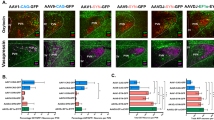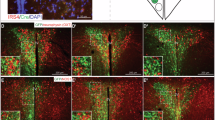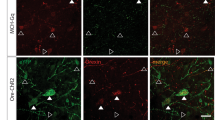Abstract
Relaxin-3 is a neuropeptide that is abundantly expressed by discrete brainstem neuron populations that broadly innervate forebrain areas rich in the relaxin-3 G-protein-coupled-receptor, RXFP3. Acute and subchronic central administration of synthetic relaxin-3 or an RXFP3-selective agonist peptide, R3/I5, increase feeding and body weight in rats. Intrahypothalamic injection of relaxin-3 also increases feeding. In this study, we developed a recombinant adeno-associated virus 1/2 (rAAV1/2) vector that drives expression and constitutive secretion of bioactive R3/I5 and assessed the effect of intrahypothalamic injections on daily food intake and body weight gain in adult male rats over 8 weeks. In vitro testing revealed that the vector rAAV1/2-fibronectin (FIB)-R3/I5 directs the constitutive secretion of bioactive R3/I5 peptide. Bilateral injection of rAAV1/2-FIB-R3/I5 vector into the paraventricular nucleus produced an increase in daily food intake and body weight gain (P<0.01, ∼23%, respectively), relative to control treatment. In a separate cohort of rats, quantitative polymerase chain reaction analysis of hypothalamic mRNA revealed strong expression of R3/I5 transgene at 3 months post-rAAV1/2-FIB-R3/I5 infusion. Levels of mRNA transcripts for the relaxin-3 receptor RXFP3, the hypothalamic ‘feeding’ peptides neuropeptide Y, AgRP and POMC, and the reproductive hormone, GnRH, were all similar to control, whereas vasopressin and oxytocin (OT) mRNA levels were reduced by ∼25% (P=0.051) and ∼50% (P<0.005), respectively, in rAAV1/2-FIB-R3/I5-treated rats (at 12 weeks, n=9/8 rats per group). These data demonstrate for the first time that R3/I5 is effective in modulating feeding in the rat by chronic hypothalamic RXFP3 activation and suggest a potential underlying mechanism involving altered OT signalling. Importantly, there was no desensitization of the feeding response over the treatment period and no apparent deleterious health effects, indicating that targeting the relaxin-3–RXFP3 system may be an effective long-term therapy for eating disorders.
This is a preview of subscription content, access via your institution
Access options
Subscribe to this journal
Receive 12 print issues and online access
$259.00 per year
only $21.58 per issue
Buy this article
- Purchase on Springer Link
- Instant access to full article PDF
Prices may be subject to local taxes which are calculated during checkout









Similar content being viewed by others
References
Bathgate RAD, Samuel CS, Burazin TCD, Layfield S, Claasz AA, Reytomas IGT et al. Human relaxin gene 3 (H3) and the equivalent mouse relaxin (M3) gene. Novel members of the relaxin peptide family. J Biol Chem 2002; 277: 1148–1157.
Burazin TCD, Bathgate RAD, Macris M, Layfield S, Gundlach AL, Tregear G . Restricted, but abundant, expression of the novel rat gene-3 (R3) relaxin in the dorsal tegmental region of brain. J Neurochem 2002; 82: 1553–1557.
Tanaka M, Iijima N, Miyamoto Y, Fukusumi S, Itoh Y, Ozawa H et al. Neurons expressing relaxin 3/INSL 7 in the nucleus incertus respond to stress. Eur J Neurosci 2005; 21: 1659–1670.
Smith CM, Shen PJ, Banerjee A, Bonaventure P, Ma S, Bathgate RAD et al. Distribution of relaxin-3 and RXFP3 within arousal, stress, affective, and cognitive circuits of mouse brain. J Comp Neurol 2010; 518: 4016–4045.
Ryan PJ, Ma S, Olucha-Bordonau FE, Gundlach AL . Nucleus incertus—an emerging modulatory role in arousal, stress and memory. Neurosci Biobehav Rev 2011; 35: 1326–1341.
Ma S, Bonaventure P, Ferraro T, Shen PJ, Burazin TCD, Bathgate RAD et al. Relaxin-3 in GABA projection neurons of nucleus incertus suggests widespread influence on forebrain circuits via G-protein-coupled receptor-135 in the rat. Neuroscience 2007; 144: 165–190.
Goto M, Swanson LW, Canteras NS . Connections of the nucleus incertus. J Comp Neurol 2001; 438: 86–122.
Olucha-Bordonau FE, Teruel V, Barcia-Gonzalez J, Ruiz-Torner A, Valverde-Navarro AA, Martinez-Soriano F . Cytoarchitecture and efferent projections of the nucleus incertus of the rat. J Comp Neurol 2003; 464: 62–97.
Liu C, Eriste E, Sutton S, Chen J, Roland B, Kuei C et al. Identification of relaxin-3/INSL7 as an endogenous ligand for the orphan G-protein-coupled receptor GPCR135. J Biol Chem 2003; 278: 50754–50764.
Sutton SW, Bonaventure P, Kuei C, Roland B, Jingcai C, Nepomuceno D et al. Distribution of G-protein-coupled receptor (GPCR)135 binding sites and receptor mRNA in the rat brain suggests a role for relaxin-3 in neuroendocrine and sensory processing. Neuroendocrinology 2004; 80: 298–307.
Banerjee A, Shen PJ, Ma S, Bathgate RA, Gundlach AL . Swim stress excitation of nucleus incertus and rapid induction of relaxin-3 expression via CRF1 activation. Neuropharmacology 2009; 58: 145–155.
Ma S, Olucha-Bordonau FE, Hossain MA, Lin F, Kuei C, Liu CL et al. Modulation of hippocampal theta oscillations and spatial memory by relaxin-3 neurons of the nucleus incertus. Learn Mem 2009; 16: 730–742.
McGowan BMC, Stanley SA, Smith KL, White NE, Connolly MM, Thompson EL et al. Central relaxin-3 administration causes hyperphagia in male wistar rats. Endocrinology 2005; 146: 3295–3300.
Smith CM, Ryan PJ, Hosken IT, Ma S, Gundlach AL . Relaxin-3 systems in the brain—the first 10 years. J Chem Neuroanat 2011; 42: 262–275.
Liu C, Chen J, Sutton S, Roland B, Kuei C, Farmer N et al. Identification of relaxin-3/INSL7 as a ligand for GPCR142. J Biol Chem 2003; 278: 50765–50770.
Sudo S, Kumagai J, Nishi S, Layfield S, Ferraro T, Bathgate RAD et al. H3 relaxin is a specific ligand for LGR7 and activates the receptor by interacting with both the ectodomain and the exoloop 2. J Biol Chem 2003; 278: 7855–7862.
Liu C, Chen J, Kuei C, Sutton S, Nepomuceno D, Bonaventure P et al. Relaxin-3/insulin-like peptide 5 chimeric peptide, a selective ligand for G protein-coupled receptor (GPCR)135 and GPCR142 over leucine-rich repeat-containing G protein-coupled receptor 7. Mol Pharmacol 2005; 67: 231–240.
Liu C, Kuei C, Sutton S, Chen J, Bonaventure P, Wu J et al. INSL5 is a high affinity specific agonist for GPCR142 (GPR100). J Biol Chem 2005; 280: 292–300.
McGowan BM, Stanley SA, Donovan J, Thompson EL, Patterson M, Semjonous NM et al. Relaxin-3 stimulates the hypothalamic-pituitary-gonadal axis. Am J Physiol Endocrinol Metab 2008; 295: E278–E286.
McGowan BM, Stanley SA, Smith KL, Minnion JS, Donovan J, Thompson EL et al. Effects of acute and chronic relaxin-3 on food intake and energy expenditure in rats. Regul Pept 2006; 136: 72–77.
McGowan BM, Stanley SA, White NE, Spangeus A, Patterson M, Thompson EL et al. Hypothalamic mapping of orexigenic action and Fos-like immunoreactivity following relaxin-3 administration in male Wistar rats. Am J Physiol Endocrinol Metab 2007; 292: E913–E919.
Kuei C, Sutton S, Bonaventure P, Pudiak C, Shelton J, Zhu J et al. R3(B{Delta}23 27)R/I5 chimeric peptide, a selective antagonist for GPCR135 and GPCR142 over relaxin receptor LGR7: in vitro and in vivo characterization. J Biol Chem 2007; 282: 25425–25435.
de Backer M, Fitzsimons C, Brans M, Luijendijk M, Garner K, Vreugdenhil E et al. An adeno-associated viral vector transduces the rat hypothalamus and amygdala more efficient than a lentiviral vector. BMC Neurosci 2010; 11: 81.
Tiesjema B, la Fleur SE, Luijendijk MC, Adan RA . Sustained NPY overexpression in the PVN results in obesity via temporarily increasing food intake. Int J Obes 2009; 17: 1448–1450.
McCown TJ . Adeno-associated virus-mediated expression and constitutive secretion of galanin suppresses limbic seizure activity in vivo. Mol Ther 2006; 14: 63–68.
Noe F, Pool AH, Nissinen J, Gobbi M, Bland R, Rizzi M et al. Neuropeptide Y gene therapy decreases chronic spontaneous seizures in a rat model of temporal lobe epilepsy. Brain 2008; 131: 1506–1515.
Bathgate RAD, Lin F, Hanson NF, Otvos L, Guidolin A, Giannakis C et al. Relaxin-3: Improved synthesis strategy and demonstration of its high-affinity interaction with the relaxin receptor LGR7 both in vitro and in vivo. Biochemistry 2006; 45: 1043–1053.
Nakayama K . Furin: a mammalian subtilisin/Kex2p-like endoprotease involved in processing of a wide variety of precursor proteins. Biochem J 1997; 327: 625–635.
Ruoslahti E . Fibronectin and its receptors. Annu Rev Biochem 1988; 57: 375–413.
Foti S, Haberman RP, Samulski RJ, McCown TJ . Adeno-associated virus-mediated expression and constitutive secretion of NPY or NPY13-36 suppresses seizure activity in vivo. Gene Therapy 2007; 14: 1534–1536.
Foti SB, Samulski RJ, McCown TJ . Delivering multiple gene products in the brain from a single adeno-associated virus vector. Gene Therapy 2009; 16: 1314–1319.
Schafer MKH, Day R, Cullinan WE, Chretien M, Seidah NG, Watson SJ . Gene-expression of prohormone and proprotein convertases in the rat CNS—a comparative in situ hybridization analysis. J Neurosci 1993; 13: 1258–1279.
Regev L, Ezrielev E, Gershon E, Gil S, Chen A . Genetic approach for intracerebroventricular delivery. Proc Natl Acad Sci USA 2010; 107: 4424–4429.
Hida T, Takahashi E, Shikata K, Hirohashi T, Sawai T, Seiki T et al. Chronic intracerebroventricular administration of relaxin-3 increases body weight in rats. J Recept Signal Transduct 2006; 26: 147–158.
Bathgate RAD, Lekgabe ED, McGuane JT, Su Y, Pham T, Ferraro T et al. Adenovirus-mediated delivery of relaxin reverses cardiac fibrosis. Mol Cell Endocrinol 2008; 280: 30–38.
Chen WB, Shields TS, Stork PJS, Cone RD . A colorimetric assay for measuring activation of G(S)-coupled and G(Q)-coupled signaling pathways. Anal Biochem 1995; 226: 349–354.
Zolotukhin S, Byrne BJ, Mason E, Zolotukhin I, Potter M, Chesnut K et al. Recombinant adeno-associated virus purification using novel methods improves infectious titer and yield. Gene Therapy 1999; 6: 973–985.
Veldwijk MR, Topaly J, Laufs S, Hengge UR, Wenz F, Zeller WJ et al. Development and optimization of a real-time quantitative PCR-based method for the titration of AAV-2 vector stocks. Mol Ther 2002; 6: 272–278.
de Backer MWA, Brans MAD, Luijendijk MC, Garner KM, Adan RAH . Optimization of adeno-associated viral vector-mediated gene delivery to the hypothalamus. Hum Gene Ther 2010; 21: 673–682.
Cowley MA, Smart JL, Rubinstein M, Cordan MG, Diano S, Horvath TL et al. Leptin activates anorexigenic POMC neurons through a neural network in the arcuate nucleus. Nature 2001; 411: 480–484.
Korner J, Savontaus E, Chua SC, Leibel RL, Wardlaw SL . Leptin regulation of AgRP and NPY mRNA in the rat hypothalamus. J Neuroendocrinol 2001; 13: 959–966.
Olszewski PK, Klockars A, Schiöth HB, Levine AS . Oxytocin as feeding inhibitor: maintaining homeostasis in consummatory behavior. Pharmacol Biochem Behav 2010; 97: 47–54.
Schrier RW, Berl T, Anderson RJ . Osmotic and non-osmotic control of vasopressin release. Am J Physiol 1979; 236: F321–F332.
Wilkinson TN, Bathgate RAD . The Evolution of the Relaxin Peptide Family and their Receptors: Relaxin and Related Peptides. Springer-Verlag: Berlin, 2007, pp 1–13.
Chen J, Kuei C, Sutton SW, Bonaventure P, Nepomuceno D, Eriste E et al. Pharmacological characterization of relaxin-3/INSL7 receptors GPCR135 and GPCR142 from different mammalian species. J Pharmacol Exp Ther 2005; 312: 83–95.
Hossain MA, Bathgate RAD, Rosengren KJ, Shabanpoor F, Zhang SD, Lin F et al. The structural and functional role of the B-chain C-terminal arginine in the relaxin-3 peptide antagonist, R3(B Delta 23-27)R/I5. Chem Biol Drug Des 2009; 73: 46–52.
Fitzsimons HL, Bland RJ, During MJ . Promoters and regulatory elements that improve adeno-associated virus transgene expression in the brain. Methods 2002; 28: 227–236.
Gray SJ, Foti SB, Schwartz JW, Bachaboina L, Taylor-Blake B, Coleman J et al. Optimizing promoters for recombinant adeno-associated virus-mediated gene expression in the peripheral and central nervous system using self-complementary vectors. Hum Gene Ther 2011; 22: 1143–1153.
Haugaard-Kedstrom LM, Shabanpoor F, Hossain MA, Clark RJ, Ryan PJ, Craik DJ et al. Design, synthesis, and characterization of a single-chain peptide antagonist for the relaxin-3 receptor RXFP3. J Am Chem Soc 2011; 133: 4965–4974.
Tiesjema B, la Fleur SE, Luijendijk MC, Brans MA, Lin EJ, During MJ et al. Viral mediated neuropeptide Y expression in the rat paraventricular nucleus results in obesity. Int J Obes 2007; 15: 2424–2435.
Tiesjema B, Adan RA, Luijendijk MC, Kalsbeek A, la Fleur SE . Differential effects of recombinant adeno-associated virus-mediated neuropeptide Y overexpression in the hypothalamic paraventricular nucleus and lateral hypothalamus on feeding behavior. J Neurosci 2007; 27: 14139–14146.
de Backer MWA, la Fleur SE, Brans MAD, van Rozen AJ, Luijendijk MCM, Merkestein M et al. Melanocortin receptor-mediated effects on obesity are distributed over specific hypothalamic regions. Int J Obes 2011; 35: 629–641.
Small CJ, Liu YL, Stanley SA, Connoley IP, Kennedy A, Stock MJ et al. Chronic CNS administration of Agouti-related protein (AgRP) reduces energy expenditure. Int J Obes Relat Metab Disord 2003; 27: 530–533.
Billington CJ, Briggs JE, Grace M, Levine AS . Effects of intracerebroventricular injection of neuropeptide-Y on energy-metabolism. Am J Physiol 1991; 260: R321–R327.
Stanley BG, Daniel DR, Chin AS, Leibowitz SF . Paraventricular nucleus injections of peptide-YY and neuropeptide-Y preferentially enhance carbohydrate ingestion. Peptides 1985; 6: 1205–1211.
Klein RL, Hamby ME, Gong Y, Hirko AC, Wang S, Hughes JA et al. Dose and promoter effects of adeno-associated viral vector for green fluorescent protein expression in the rat brain. Exp Neurol 2002; 176: 66–74.
Yulyaningsih E, Zhang L, Herzog H, Sainsbury A . NPY receptors as potential targets for anti-obesity drug development. Br J Pharmacol 2011; 163: 1170–1202.
Kamiji MM, Inui A . NPY Y(2) and Y(4) receptors selective ligands: promising anti-obesity drugs? Curr Top Med Chem 2007; 7: 1734–1742.
Wu G, Feder A, Wegener G, Bailey C, Saxena S, Charney D et al. Central functions of neuropeptide Y in mood and anxiety disorders. Expert Opin Ther Targets 2011; 15: 1317–1331.
Richichi C, Lin E-JD, Stefanin D, Colella D, Ravizza T, Grignaschi G et al. Anticonvulsant and antiepileptogenic effects mediated by adeno-associated virus vector neuropeptide Y expression in the rat hippocampus. J Neurosci 2004; 24: 3051–3059.
Ganella DE, Ryan PJ, Bathgate RA, Gundlach AL . Increased feeding and body weight gain in rats after acute and chronic activation of RXFP3 by relaxin-3 and receptor-selective peptides: functional and therapeutic implications. Behav Pharmacol 2012; 23: 516–525.
Olson BR, Drutarosky MD, Chow MS, Hruby VJ, Stricker EM, Verbalis JG . Oxytocin and an oxytocin agonist administered centrally decrease food-intake in rats. Peptides 1991; 12: 113–118.
Gaetani S, Fu J, Cassano T, Dipasquale P, Romano A, Righetti L et al. The fat-induced satiety factor oleoylethanolamide suppresses feeding through central release of oxytocin. J Neurosci 2010; 30: 8096–8101.
Olson BR, Drutarosky MD, Stricker EM, Verbalis JG . Brain oxytocin receptor antagonism blunts the effects of anorexigenic treatment in rats—evidence for central oxytocin inhibition of food-intake. Endocrinology 1991; 129: 785–791.
Callander GE, Thomas WG, Bathgate RAD . Development and optimization of microRNA against relaxin-3. Ann NY Acad Sci 2009; 1160: 261–264.
Van Der Westhuizen ET, Sexton PM, Bathgate RAD, Summers RJ . Responses of GPCR135 to human gene 3 (H3) relaxin in CHO-KI cells determined by microphysiometry. Ann NY Acad Sci 2005; 1041: 332–337.
Haugaard-Jonsson LM, Hossain MA, Daly NL, Bathgate RAD, Wade JD, Craik DJ et al. Structure of the R3/I5 chimeric relaxin peptide, a selective GPCR135 and GPCR142 agonist. J Biol Chem 2008; 283: 23811–23818.
Grimm D, Kay MA, Kleinschmidt JA . Helper virus-free, optically controllable, and two-plasmid-based production of adeno-associated virus vectors of serotypes 1 to 6. Mol Ther 2003; 7: 839–850.
Paxinos G, Watson C . The Rat Brain In Stereotaxic Coordinates. Academic Press: New York, 1986.
Callander GE, Ma S, Ganella DE, Wimmer VC, Gundlach AL, Thomas WG et al. Silencing relaxin-3 in nucleus incertus of adult rodents: a viral vector-based approach to investigate neuropeptide function. PLoS One 2012; 7: e42300.
Livak KJ, Schmittgen TD . Analysis of relative gene expression data using real-time quantitative PCR and the 2(T)(−ΔΔC) method. Methods 2001; 25: 402–408.
Schmittgen TD, Livak KJ . Analyzing real-time PCR data by the comparative C–T method. Nat Protoc 2008; 3: 1101–1108.
Rozen S, Skaletsky H . Primer3 on the WWW for general users and for biologist programmers. Bioinformatics Methods and Protocols: Methods in Molecular Biology. Humana Press: Totowa, NJ, 2000, pp 365–386.
Lindblom J, Haitina T, Fredriksson R, Schioth HB . Differential regulation of nuclear receptors, neuropeptides and peptide hormones in the hypothalamus and pituitary of food restricted rats. Mol Brain Res 2005; 133: 37–46.
Acknowledgements
We thank Dr Melanie White, Tania Ferraro and Professor Michael McKinley for technical assistance, Dr Changlu Liu (Johnson & Johnson Pharmaceutical Research and Development LLC, San Diego, CA, USA) for provision of the pCMVSportR3/I5 construct, Professor Thomas McCown (University of North Carolina, Chapel Hill, NC, USA) for the kind gift of the TR-FIB-GFP construct, Dr Michael Mathai (Victoria University, Melbourne, VIC, Australia) for the use of the Echo-MRI Body Composition Analyser and Prof. Geoffrey Tregear for his continuing support. This research was supported by National Health and Medical Research Council of Australia Project Grants 509246 (ALG) and 1005988 (ALG, RADB), and by the Victorian Government Operational Infrastructure Support Programme. DEG is the recipient of Commonwealth Australian Postgraduate Award and GEC was the recipient of a University of Melbourne Research Scholarship. SM and ALG and RADB are recipients of NHMRC (Australia) Training and Research Fellowships, respectively.
Author information
Authors and Affiliations
Corresponding author
Ethics declarations
Competing interests
The authors declare no conflict of interest.
Rights and permissions
About this article
Cite this article
Ganella, D., Callander, G., Ma, S. et al. Modulation of feeding by chronic rAAV expression of a relaxin-3 peptide agonist in rat hypothalamus. Gene Ther 20, 703–716 (2013). https://doi.org/10.1038/gt.2012.83
Received:
Revised:
Accepted:
Published:
Issue Date:
DOI: https://doi.org/10.1038/gt.2012.83



